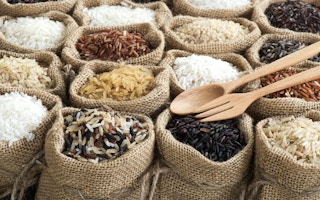A stamp of green farming practices could soon be on the label of rice bags in consumer markets.
The Sustainable Rice Platform (SRP), the world’s first voluntary standards for “green” rice, is being rolled out by the International Rice Research Institute (IRRI) and the UN Environment Programme (UNEP) which they announced last week (27 October) in a move to increase rice production and farm income while also adhering to good agricultural practices and lessening rice’s negative impact.
IRRI calculates that by 2050, the rice-eating world will require 50 per cent more of the staple. The increase will mostly come from intensified production to sate the appetite of more than 3.5 billion people worldwide who depend on rice for more than 20 per cent of their calorie needs.
But growing rice impacts big time on the environment. Irrigation uses 30-40 per cent of the world’s freshwater supply. Rice cultivation contributes up to 10 per cent of methane emissions, a major cause of global warming.
The SRP contains checklists (ranging from productivity, food safety, worker health, labour rights to biodiversity) and indicators, including 160 recommended best practices and 46 requirements.
The checklists draw on similar initiatives for sugarcane, cotton, coffee and oil palm.
The standards and indicators represent “the world’s first initiative that will set environmentally sustainable and socially responsible rice production management standards”, says Robert Zeigler, IRRI director general.
For instance, the SRP recommends “alternate wetting and drying”, which floods and then drains rice fields, reducing water use without reducing yields. This decreases methane emissions by up to 70 per cent, says Bas Bauman, director of IRRI’s Global Rice Science Partnership.
“Our key challenge now is to scale up adoption, especially among poor farmers,” Zeigler emphasises.
“[Farmers] will help ensure that the cultivation of this vital commodity becomes more sustainable and benefits people, communities and the planet,” explains Kaveh Zahedi, UNEP regional director for Asia and the Pacific.
Six pilot projects will extensively test the SRP standards to determine market mechanisms and what national governments can do to promote the standards.
The SRP is supported by major players in the global rice supply chain: Kellogg’s, Mars Food and Nestlé; agrochemical and seed companies Syngenta, BASF South East Asia and Bayer; Van Sillevoldt Rijst B.V. which supplies natural rice to Europe’s retail and food industry; seed-to-shelf agribusiness Olam International; and retailer Ahold B.V. of The Netherlands.
“(The SRP) is not just for the supply chain, it represents a definition of sustainability to be incorporated into policies,” notes Wyn Ellis, UNEP SRP coordinator.








